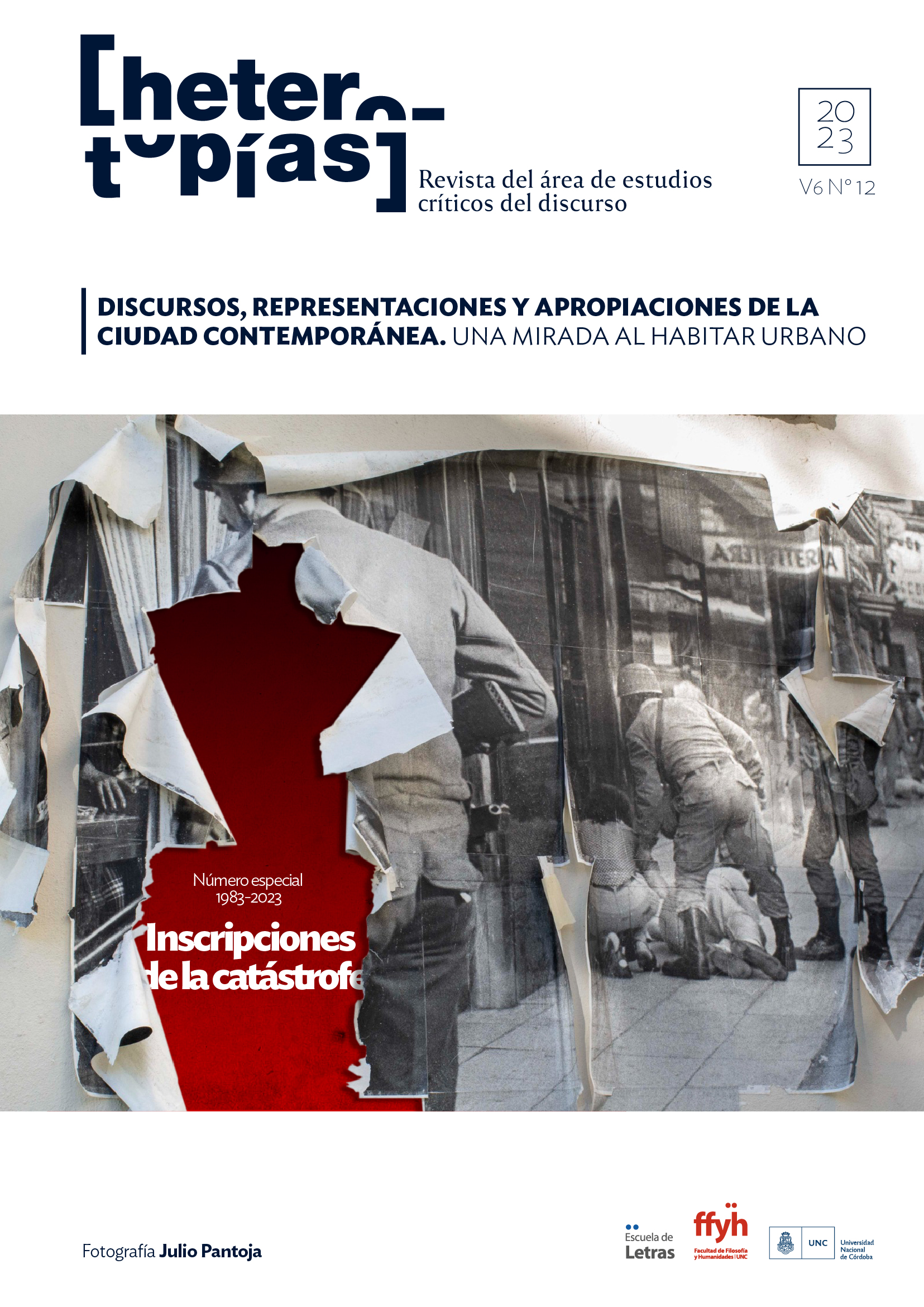Aesthetic (pre)figurations of the anthropocene in Fernanda Trías’ Mugre rosa, a poetics in the flesh
Main Article Content
Abstract
This essay analyzes the book Mugre rosa (2021) by Uruguayan writer Fernanda Trías as a fiction of the Anthropocene. I argue that this text belongs to a set of aesthetic artifacts that engages in the debates around the current geological era, suggests aesthetic figurations of the material and the living, promotes a perspective from Gaia and engages in the construction of a new sensibility and a new language to inhabit the Anthropocene. From my perspective, this narrative is situated at a temporal edge from which it observes and testifies to the peeling of a cultural imaginary of modernity that is incompatible with the social perception of the times in which we live. Thus, I argue that this book by Trías presents a series of modulations of skinning that point towards the same semantic gesture. By skinning I mean the act of flaying, that is, of removing an old skin or surface and leaving the body in the flesh. Through narrative techniques, tropes, stark language and its structure, the novel composes a Gaia, a temporality, and a writing that, once the skins have fallen off, are left red-hot.
In what follows, I develop the idea of fiction of the Anthropocene while referring to the state of current debates about this era. Then, I expose and justify the notion of skinning to account for an aesthetic and political operation of Mugre rosa that strives to take responsibility for our time and compose a new sensibility. Furthermore, I propose that the book takes on a Gaia perspective which prompts us to rethink humanity's relationship with earth systems and waste.
Downloads
Article Details

This work is licensed under a Creative Commons Attribution-NonCommercial-ShareAlike 4.0 International License.
Those authors who have publications with this journal, accept the following terms: Those authors who have publications with this journal, accept the following terms:
a. The authors will keep their copyright and guarantee to the journal the right of first publication of their work, which will be simultaneously subject to the Creative Commons Attribution - Non-Commercial - Share Alike (by-nc-sa) Attribution License; no commercial use of the original work or any derivative works is allowed, the distribution of which must be done with a license equal to the one that regulates the original work.
b. Authors may adopt other non-exclusive license agreements for the distribution of the published version of the work (e.g., deposit it in an institutional telematic archive or publish it in a monographic volume) provided that the initial publication in this journal is indicated.
c. Authors are allowed and recommended to disseminate their work through the Internet (e.g. in institutional telematic archives or on their website) before and during the submission process, which may lead to interesting exchanges and increase the number of citations of the published work. (See The effect of open access).
How to Cite
References
Arias Maldonado, M. (2016). "El giro antropocénico. Sociedad y medio ambiente en la era global" en Política y Sociedad, 53(3), 795-814.
Bonneuil, C. et al. (Eds.). (2015). The Anthropocene and the Global Environmental Crisis. Rethinking Modernity in a New Epoch. Routledge.
Cortes Rocca, P. y L. Horne. (2021). "La imaginación material. Restos, naturaleza y vida en la estética latinoamericana contemporánea". Estudios de Teoría Literaria - Revista digital: artes, letras y humanidades, 10(21), 4-15.
de los Ríos, V. (2021). "Restos espectrales: materialidades residuales y representación del territorio en documentales latinoamericanos". Estudios de Teoría Literaria. Revista digital: artes, letras y humanidades, 10(21), 55-67.
Domínguez, N. (2021). "Líneas de tiempo, vueltas de lectura, cuerpos en suspensión". Revista Heterotopías del Área de Estudios Críticos del Discurso de FFyH, 4(7), 1-14.
Gerbase, Iuli (Directora). (2021). Nube rosa. [Película] Prana Filmes (Productora).
Haraway, D. J. (2019) Seguir con el problema. Generar parentesco en el Chthuluceno. España, Bilbao: Consonni.
Heffes, G. (2021). "Escrituras tóxicas: cuerpos y paisajes alterados". Tekoporá. Revista Latinoamericana De Humanidades Ambientales Y Estudios Territoriales, 3(1), 348-370.
Heffes, G. (anfitriona). (mayo de 2022). Estéticas del Antropoceno. Tres preguntas (N° 342) [Episodio de podcast] En Hablemos Escritoras. Spotify.
https://open.spotify.com/episode/2VdJXeQWu8Pv9F4FonMm1W
La Danta Las Canta (2017). "El Faloceno: redefinir el Antropoceno desde una mirada ecofeminista". Ecología Política, 53, 26-33.
Latour, B. (2012). "Esperando a Gaia. Componer el mundo común mediante las artes y la política". Trad. por: Sylvina Cucchi. Cuadernos de Otra Parte. Revista de letras y artes, 26, 67-76.
Lovelock, J. (2017). The Revenge of Gaia. Earth's Climate Crisis & the Fate of Humanity. New York: Penguin Group.
Moore, J. W et al. (Eds.). (2016). Anthropocene or Capitalocene? Nature, History, and the Crisis of Capitalism. PM Press/Kairos.
Mukarovský, J. (2000) Signo, Función y Valor. Estética y Semiótica del arte de Jan Mukarovský. Ed., intr. y trad. de Jarmila Jandová y Emil Volek. Santafé de Bogotá, Plaza & Janés Editores Colombia S.A.
Nancy, J.L. (2015). Dar Piel. Ecuador, Quito: Trashumante.
Pratt, M. L. (2017). "Coda: concept and chronotope" en Anna Tsing, Heather Swanson, Elaine Gan y Nils Buband (Eds.), Arts of Living on a Damaged Planet. Ghosts and Monsters of the Anthropocene. University of Minnesota Press,169-173.
Robin, L. et al. (Eds.). (2013) "The Anthropocene". The Future of Nature: Documents of Global Change. New Haven: Yale University Press.
Rosenberg, F. J. (2023) “Maternar: familiaridades extrañas en Los niños de Carolina Sanín, La hija única de Guadalupe Nettel, La perra de Pilar Quintana y Mugre rosa de Fernanda Trías”. Revista Iberoamericana, LXXXIX(282-283), 175-194.
Sánchez, L. (2022) "Futuros tóxicos / realidades alternativas en la narrativa latinoamericana del siglo xxi: el caso Agustina Bazterrica, Rita Indiana y Fernanda Trías". Revista Casa de las Américas, 307, 124-130.
Svampa, M. (2019). “Antropoceno. Lecturas globales desde el Sur”. M. Svampa. Antropoceno. Lecturas globales desde el Sur. Argentina, Córdoba: “La Sofía cartonera” Editorial Cartonera de la Facultad de Filosofía y Humanidades de la Universidad Nacional de Córdoba, 5-44.
Trías, F. (2021) Mugre rosa. Colombia, Bogotá: Literatura Random House.
Williams, R. (2000) Marxismo y literatura. España, Barcelona: Ediciones Península.
